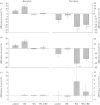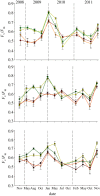Warming reduces the growth and diversity of biological soil crusts in a semi-arid environment: implications for ecosystem structure and functioning
- PMID: 23045707
- PMCID: PMC3479686
- DOI: 10.1098/rstb.2011.0344
Warming reduces the growth and diversity of biological soil crusts in a semi-arid environment: implications for ecosystem structure and functioning
Abstract
Biological soil crusts (BSCs) are key biotic components of dryland ecosystems worldwide that control many functional processes, including carbon and nitrogen cycling, soil stabilization and infiltration. Regardless of their ecological importance and prevalence in drylands, very few studies have explicitly evaluated how climate change will affect the structure and composition of BSCs, and the functioning of their constituents. Using a manipulative experiment conducted over 3 years in a semi-arid site from central Spain, we evaluated how the composition, structure and performance of lichen-dominated BSCs respond to a 2.4°C increase in temperature, and to an approximately 30 per cent reduction of total annual rainfall. In areas with well-developed BSCs, warming promoted a significant decrease in the richness and diversity of the whole BSC community. This was accompanied by important compositional changes, as the cover of lichens suffered a substantial decrease with warming (from 70 to 40% on average), while that of mosses increased slightly (from 0.3 to 7% on average). The physiological performance of the BSC community, evaluated using chlorophyll fluorescence, increased with warming during the first year of the experiment, but did not respond to rainfall reduction. Our results indicate that ongoing climate change will strongly affect the diversity and composition of BSC communities, as well as their recovery after disturbances. The expected changes in richness and composition under warming could reduce or even reverse the positive effects of BSCs on important soil processes. Thus, these changes are likely to promote an overall reduction in ecosystem processes that sustain and control nutrient cycling, soil stabilization and water dynamics.
Figures




Similar articles
-
Southern African biological soil crusts are ubiquitous and highly diverse in drylands, being restricted by rainfall frequency.Microb Ecol. 2009 Feb;57(2):229-47. doi: 10.1007/s00248-008-9449-9. Epub 2008 Oct 11. Microb Ecol. 2009. PMID: 18850242
-
Changes in biocrust cover drive carbon cycle responses to climate change in drylands.Glob Chang Biol. 2013 Dec;19(12):3835-47. doi: 10.1111/gcb.12306. Epub 2013 Sep 11. Glob Chang Biol. 2013. PMID: 23818331 Free PMC article.
-
Hydrological response of biological soil crusts to global warming: A ten-year simulative study.Glob Chang Biol. 2018 Oct;24(10):4960-4971. doi: 10.1111/gcb.14378. Epub 2018 Jul 18. Glob Chang Biol. 2018. PMID: 29957890
-
Impacts of altered precipitation regimes on soil communities and biogeochemistry in arid and semi-arid ecosystems.Glob Chang Biol. 2015 Apr;21(4):1407-21. doi: 10.1111/gcb.12789. Epub 2014 Dec 5. Glob Chang Biol. 2015. PMID: 25363193 Review.
-
Biological soil crusts and how they might colonize other worlds: insights from these Brazilian ecosystem engineers.J Exp Bot. 2022 Jul 16;73(13):4362-4379. doi: 10.1093/jxb/erac162. J Exp Bot. 2022. PMID: 35522077 Review.
Cited by
-
Albedo feedbacks to future climate via climate change impacts on dryland biocrusts.Sci Rep. 2017 Mar 10;7:44188. doi: 10.1038/srep44188. Sci Rep. 2017. PMID: 28281687 Free PMC article.
-
Biogeochemical indicators of elevated nitrogen deposition in semiarid Mediterranean ecosystems.Environ Monit Assess. 2014 Sep;186(9):5831-42. doi: 10.1007/s10661-014-3822-6. Epub 2014 Jun 4. Environ Monit Assess. 2014. PMID: 24894911 Free PMC article.
-
Continuous monitoring of chlorophyll a fluorescence and microclimatic conditions reveals warming-induced physiological damage in biocrust-forming lichens.Plant Soil. 2023;482(1-2):261-276. doi: 10.1007/s11104-022-05686-w. Epub 2022 Sep 9. Plant Soil. 2023. PMID: 36714192 Free PMC article.
-
Climate change and physical disturbance manipulations result in distinct biological soil crust communities.Appl Environ Microbiol. 2015 Nov;81(21):7448-59. doi: 10.1128/AEM.01443-15. Epub 2015 Aug 14. Appl Environ Microbiol. 2015. PMID: 26276111 Free PMC article.
-
Microsite Differentiation Drives the Abundance of Soil Ammonia Oxidizing Bacteria along Aridity Gradients.Front Microbiol. 2016 Apr 18;7:505. doi: 10.3389/fmicb.2016.00505. eCollection 2016. Front Microbiol. 2016. PMID: 27148194 Free PMC article.
References
-
- Le Houeroun H. N. 1996. Climate change, drought and desertification. J. Arid Environ. 34, 133–18510.1006/jare.1996.0099 (doi:10.1006/jare.1996.0099) - DOI - DOI
-
- Maestre F. T., Salguero-Gómez R., Quero J. L. 2012. It is getting hotter in here: determining and projecting the impacts of global environmental change on drylands. Phil. Trans. R. Soc. B 367, 3062–307510.1098/rstb.2011.0323 (doi:10.1098/rstb.2011.0323) - DOI - DOI - PMC - PubMed
-
- IPCC 2007. Observed changes in climate and their effects. In Climate Change 2007: Synthesis Report (eds Core Writing Team, Pachauri R. K., Reisinger A.), 104 pp Geneva, Switzerland: IPCC
-
- McCarty J. P. 2001. Ecological consequences of recent climate change. Conserv. Biol. 15, 320–33110.1046/j.1523-1739.2001.015002320.x (doi:10.1046/j.1523-1739.2001.015002320.x) - DOI - DOI
-
- Walther G. R., et al. 2010. Community and ecosystem responses to recent climate change. Phil. Trans. R. Soc. B. 365, 2019–202410.1098/rstb.2010.0021 (doi:10.1098/rstb.2010.0021) - DOI - DOI - PMC - PubMed
Publication types
MeSH terms
Substances
Grants and funding
LinkOut - more resources
Full Text Sources
Other Literature Sources

